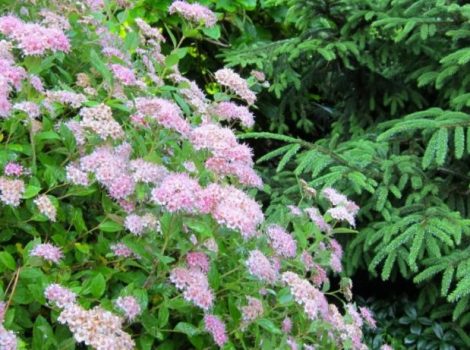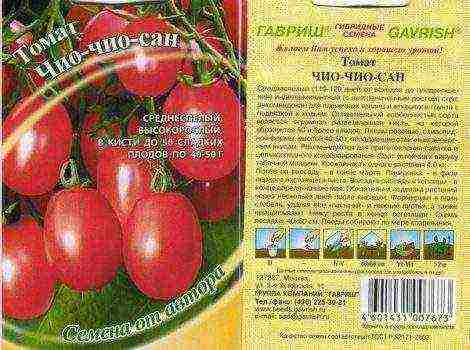Content [show]
We offer a list of nine varieties of miniature border roses that boast beautiful flowers and unpretentious care.
As a rule, low and medium-sized varieties are referred to as border roses, the height of which does not exceed 50-60 cm. The bushes of these plants are compact enough, do not take up much space and frame the garden with a beautiful border. The special pride of this group of roses is medium-sized flowers with double buds.
We have selected nine of the most luxurious varieties of border roses.
1. Biedermeier
Biedermeier is a modern variety, bred in 2004. Large flowers, reaching 8 cm in diameter, look charming on a low, spreading bush. White petals are framed with a pink border. The foliage of this variety is dark green, shiny. This flower will be a real decoration for your garden.
Biedermeier is quite resistant to powdery mildew and black spot. It endures the winter with dignity. The main disadvantage of Biedermeier is an acute "dislike" for rain. In a particularly rainy summer, the buds can rot without opening. In a favorable year, the rose blooms actively several times per season.
| Appointment | Plant height | Bloom | Scent | Winter hardiness |
| 40-50 cm |
Abundant, remontant (the first wave - in June-July, the second - in August-September) |
Average | High | |
2. Lydia
The Dutch rose variety Lydia was bred in 1990 for cultivation in greenhouses, but with proper shelter for the winter, it does well in the open field. Lydia is a spray rose with small flowers 3-6 cm in diameter that grow 5-10 per stem. The color of the petals ranges from pale pink to creamy.
An interesting feature of the Lydia rose is that in cloudy weather its flowers acquire a darker color, and brighten in the sun.
This rose looks great in bouquets, suitable for group plantings and borders.
| Appointment | Plant height | Bloom | Scent | Winter hardiness |
| 50-60 cm |
Abundant, continuous (from early summer to October) |
Easy |
Average |
|
3. Impala Kordana
The rose with the unusual name Impala Cordana is a spectacular beauty with cupped buds of a rich apricot color. The diameter of the flowers is 4-6 cm. Their shade, which is more saturated at the base, brightens towards the edge. The petals are slightly curved, giving the flower the shape of a ball. Leaves are green, matte. The aroma is light, subtle.
The rose practically does not get sick, is not afraid of rain. Blooms from early summer to early autumn. Suitable for cutting and growing in containers.
| Appointment | Plant height | Bloom | Scent | Winter hardiness |
| 30-40 cm |
Abundant, continuous (June to September) |
Easy |
Average |
|
4. Baby Masquerade
A proven German variety, it has been popular for over half a century. It was withdrawn back in 1955.
Terry flowers, 3-5 cm in diameter, collected in a brush. Exudes a light fruity aroma.The foliage is small, shiny, dark green. The best part is that there are few thorns on the stem.
Baby Masquerade tolerates winter well, disease resistant. Feels good enough in rainy weather.
This rose is a chameleon. The flowers change shade from yellow to pink-red during flowering: as the bud opens, the petals bend down and turn red. If you plant this rose in your garden, you will not regret: flowers of several shades will flaunt on the bush at the same time - from bright yellow to rich crimson.
In order for the plant to feel well and bloom actively, wilted flowers must be cut off in time.
Baby Masquerade grows well in containers and pots, suitable for curbs and mixborders.
| Appointment | Plant height | Bloom | Scent | Winter hardiness |
| 20-30 cm |
Abundant, remontant |
Light, fruity | High | |
5. Brilliant Sweet Dream
A young British variety, bred in 2011, the main advantage of which is its bright, showy buds. Flowers are small - 3-5 cm in diameter, grow in umbrellas, 5-10 pieces per stem. The petals are golden yellow at the base, orange at the edges.
Diamond Sweet Dream is resistant to diseases, tolerates rain well, winters well.
| Appointment | Plant height | Bloom | Scent | Winter hardiness |
| 40-45 cm |
Abundant, continuous |
Easy, |
Medium (requires |
|
6. Green Ice
An excellent variety, bred in 1971, the rose has beautiful white double flowers with a barely noticeable greenish undertone. The diameter of the flowers is small - 3-4 cm, 3-5 buds grow on the stem. The foliage is dark green, shiny. Branched bush, up to 80 cm wide.
Green Ice is not afraid of rain, is very resistant to disease, tolerates frost and practically does not need insulation. The rose blooms actively all summer. Ideal for curbs and container and pot growing.
To stimulate re-flowering, it is advisable to cut off wilted inflorescences. These roses love partial shade, but do not lose their aesthetic qualities in the bright sun.
| Appointment | Plant height | Bloom | Scent | Winter hardiness |
| 50-60 cm |
Abundant, continuous |
Lightweight, fresh | Very high | |
7. Sugar Baby
The Sugar Baby variety was bred in 1997 in Germany and since then has received excellent marks from gardeners due to its excellent appearance and unpretentious care.
Sugar Baby boasts bright pink double flowers with a diameter of about 5 cm and lush, shiny dark green foliage. The bush branches well and reaches 50 cm in width.
This variety is practically not susceptible to powdery mildew and black spot, shows high winter hardiness.
| Appointment | Plant height | Bloom | Scent | Winter hardiness |
| 50-60 cm |
Abundant, remontant |
Light, sweet | High | |
8. Korsnoda
Another name for the variety is White Bouquet.
Korsnoda is a fairly young variety of roses. It was bred in 2007, but has already managed to win the recognition of gardeners and receive a lot of praise. Blooms profusely and continuously throughout the season. Ideal for curbs.
Flowers with a diameter of 4-5 cm are painted in snow-white or milky color. The petals are bent down. The bush is wide enough - 75 cm in diameter. The stem contains 3-5 flowers. The foliage is green, matte.
Korsnoda is not afraid of diseases, rain or frost and is very easy to care for. She has a subtle fresh scent.
| Appointment | Plant height | Bloom | Scent | Winter hardiness |
| 50-60 cm |
Abundant, continuous |
Weak | High | |
9. Apricot Clementine
The Epricot Clementine variety was bred relatively recently - in 2001. Its medium-sized double buds (4-6 cm in diameter) in the process of flowering change their shade from pale salmon to peach. Roses of this variety retain their color in the bright sun, and also tolerate partial shade well. 4-5 flowers grow on the stem. A wide, upright bush with dark green shiny leaves reaches a height of 50 cm.
This miniature rose blooms profusely from early summer until frost.Epricot Clementin can be grown both in containers and in soil. The variety is resistant to powdery mildew and black spot and practically does not get sick even in unfavorable years. It tolerates frost well: with sufficient snow cover, it is not necessary to cover the rose for the winter.
| Appointment | Plant height | Bloom | Scent | Winter hardiness |
| 30-50 cm |
Abundant, continuous |
Weak, practically absent |
High | |
As you can see, roses are not so capricious beauties as people usually think of them. Any of the ones presented in our review will survive the winter with dignity and frame your garden with a luxurious border.
 Roses are the collective name for all species and varieties of plants belonging to the genus Rosehip or Rósa. In recent years, flower growers have increasingly cultivated border roses or "Border Rose", which can be grown not only as a garden flowering crop, but also in indoor conditions.
Roses are the collective name for all species and varieties of plants belonging to the genus Rosehip or Rósa. In recent years, flower growers have increasingly cultivated border roses or "Border Rose", which can be grown not only as a garden flowering crop, but also in indoor conditions.
Features and Benefits
Border roses are a very beautiful and rather unpretentious species, which not only differs in a variety of varieties, but is also able to amaze even the most sophisticated flower growers with its sophistication. The description and characteristics of such roses may differ significantly depending on the variety. The name of the species was obtained due to the ability to effectively decorate borders, ridges and miniature flower beds. Most often, such roses are planted near the path in the form of a decorative frame.
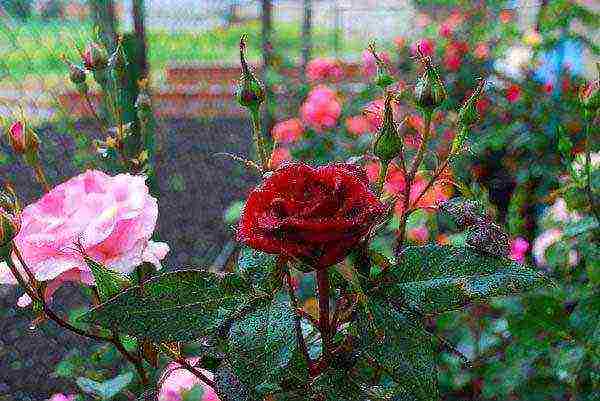
A distinctive specific feature of such roses is a very abundant and rather long flowering, as well as the unusual shape of fluffy petals. Also, the characteristics of a curb rose include the possibility of re-flowering, sufficient frost resistance, unpretentiousness in planting and care.
Due to their originality and high decorativeness, border roses are highly valued by landscape designers. All varieties of border roses belong to the category of miniature bushy ornamental plants, which makes them suitable not only for home cultivation, but also for indoor floriculture.
Border roses: varieties (video)
Also Read: Quivering Moths of Tender Escholzia
Landing technology
Planting a miniature curb rose is not too difficult a process, but all conditions must be met:
- it is impossible to plant in areas where rose bushes have been grown for a long time;
- the landing area should be well lit and not subject to the negative effects of strong winds;
- the most suitable time for planting a curb rose is the beginning of spring, which will allow the plants to take root well and easily endure winter frosts;
- the size of the planting pit should slightly exceed the diameter of the root system of the planted plant;
- a nutritious soil mixture with the addition of organic fertilizers should be poured at the bottom of the planting pit;
- during planting, it is necessary to carefully spread the root system of the rose, as well as deepen the root collar of the plant by about 3-4 cm.
After planting, the soil should be carefully compacted, as well as abundant watering of the ornamental plant.

Breeding rules
Reproduction of border species is the same as in the cultivation of other varieties of roses. In the summer, a sufficient number of shoots are formed on the rose bushes, which must be cut into cuttings with a pair of buds, after which about 50% of the foliage should be removed from them. Before planting, the cuttings should be treated with a rooting stimulant.
Planting of cuttings is carried out with a slight slope and a distance of 20-30 cm. After planting, abundant watering should be carried out and the planting should be covered with polyethylene. After about a month and a half, the rooted cuttings can be transplanted to a permanent place.
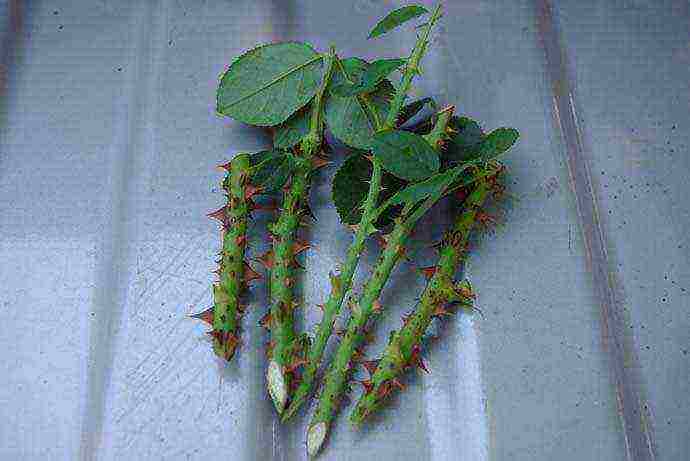
Care features
Despite the absolute unpretentiousness of the plants, when growing border roses, you should adhere to the following care recommendations:
- the key to proper care is proper pruning of rose bushes, which consists in the regular removal of all dry and damaged shoots, as well as the formation of the most attractive and decorative aboveground part;
- roses should be trimmed with an exceptionally clean and sharp garden tool, which will prevent decay and damage to the cut areas by the bacterial microflora;
- it is necessary to regularly inspect the bushes for the presence of plant parasites or disease;
- in the spring, and, if necessary, throughout the entire growing season, rose bushes are treated with preventive and therapeutic insectofungicidal preparations of prolonged action;
- border roses need systematic, but not too abundant irrigation measures;
- for irrigation, use settled water heated in the sun;
- rose watering is carried out in the evening hours, strictly under the root, preventing water from entering the aboveground part of the decorative culture;

- for feeding several times per season, you need to use special fertilizer complexes intended for roses or other flowering ornamental crops;
- a good result is achieved with the autumn and early spring composting, which is recommended to be laid out around the ornamental crop at the rate of 5-6 kg for each square meter of the flower garden.
Even frost-resistant varieties, when grown in regions with unfavorable soil and climatic conditions, need shelter for the winter period. It is best to use spruce branches or special covering garden materials for this purpose.
Border roses in landscape design
Miniature border roses are used to decorate home gardens. These very exquisite, bright, but compact enough flowers are able to perfectly combine with various garden crops. Flower beds with border roses can be of any design and shape.
Reproduction of roses: cuttings (video)
You can plant a curb of rose bushes near garden paths or stairs, and you can also place flowering crops along seating areas, gazebos or dry streams. Ornamental flowering culture can be successfully combined with herbaceous perennials or bright annuals. The final accent in the border compositions can be not only low-growing border roses, but also such ornamental shrubs as garden cranberries, Japanese spirea and dwarf barberries.
Border roses: varieties (15 photos)
Attention, only TODAY!
Reviews and comments
Did you find a mistake in the text? Please select it and press Ctrl + Enter. Thank you!
Rating:
(
estimates, average:
out of 5)
It is impossible to convey in words those feelings and emotions that appear at the sight of these amazing flowers. Correctly carried out planting of a curb rose and subsequent high-quality care will allow you to enjoy its delicate aroma and fragrant appearance in the garden for a long time.

Features of border roses
Border roses are medium and low-growing bush varieties, differing from the usual roses in height, petals, and multiple abundant flowering. Its bushes do not exceed 60 cm. They are compact, do not take up much space, and their plantings beautifully frame the plot with a picturesque border. Growing roses in the garden gives it a unique and sophisticated look.
Rose petals have a double base. The variety of colors is striking. These can be buds of one color, or combining two. There are varieties that change color during the season. So, in the “masquerade” variety, the color from bright yellow gradually turns into pink, and in the fall it becomes dark crimson.
Border roses are considered an unpretentious crop to grow, easily tolerate a transplant, quickly take root, withstand frosts.
Miniature roses are prized by designers and landscape architects. They use them to decorate streets, parks, city sites, recreation areas, "dry streams". Flowers go well with many garden plants. One of their features is that they grow beautifully both in the garden and on the windowsill in a pot.
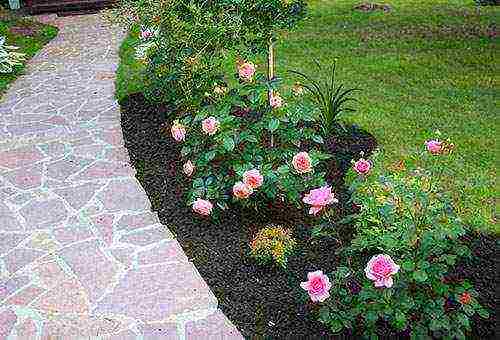
How to plant?
Planting a curb rose is a simple process, but the gardener needs to know a few important points.
- Seat selection
Landing should take place in an area protected from gusts of wind. In this case, there should be enough sunlight. A strong wind will take moisture from the crop, and its lack will affect growth and flowering. This condition is also important for roses growing in pots. The effect of the wind is enhanced, since the roots have a limited area of soil, from which they could make up for the lack of moisture.
You can not plant it on a site where other representatives of the Rosaceae family grew for a long time. The effect of "soil fatigue from roses" arises when it is greatly depleted by these plants and spores of fungal diseases, viruses and pests can be found in it.
- Soil for planting
Miniature beauties are undemanding to the composition of the soil. They grow on any soil, as long as it is not too dry, dense and waterlogged. Before planting, it is recommended to improve the soil by mixing it with drainage or organic fertilizers.
- When to plant
The best time is the beginning of spring, when the soil warms up a little. Such an early planting period makes it possible to develop well during the season, take root roots and then easily endure the winter.
Advice
While the plant takes root in a new place, it is better to cover its young bushes at night. This will protect fragile and weakened bushes from night frosts.
- How to plant
Planting is carried out in a hole, the size of which should slightly exceed the diameter of the planted root system. When planting, the roots are gently straightened, their neck is buried into the soil by only 3-5 cm.
The optimum distance between seedlings is 25-30 cm. After planting, the soil around the bush is carefully compacted and watered abundantly.

How should you care for a flower garden?
Caring for a curb rose will not cause difficulties even for those who are engaged in its cultivation for the first time. If the basic requirements for pruning, watering, feeding are met, the plant will thank you with good growth and lush flowering.
Watering
Miniature roses need regular, but not abundant irrigation. Drying and waterlogging of the earth must not be allowed. Watering is best done in the evening using sun-warmed and settled water.
Advice
Do not allow water to enter the aerial part of the plant. It should be watered at the root!
Top dressing
Growing roses is not complete without feeding. It is necessary to feed miniature plants several times. To do this, you must use fertilizers designed specifically for Rosaceae or other ornamental flowering plants. You can use organic matter: horse manure. It mixes with the soil and fits under the bushes. It is not necessary to use other manure, as the roots may burn.
Spring and autumn composting works well on miniature roses. It is laid out under the bushes at the rate of 5-6 kg per m2.
When the first buds form, the plant can be fed with calcium nitrate (1 tablespoon per bucket of water). This fertilizer has its own peculiarities of use:
- before feeding, the roses should be well watered so as not to burn them;
- after feeding - water again;
- the time of the procedure is in the morning or in the evening (when the heat subsides).
Additionally, every 15-20 days, you can feed it with mullein, mineral fertilizers or herbal infusions. Liming is necessary in September.
Advice
In hot, dry summers, top dressing is rare, in rainy summers - frequent and abundant. Young plants in the 1st year after planting are fed only in spring and autumn.
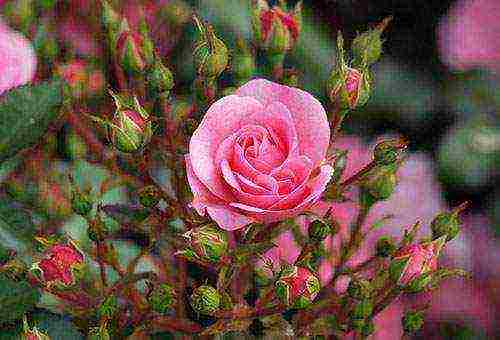
Leaving on hot days
Miniature roses do not tolerate rainy and very hot weather. It causes stress in them. During this period, reanimation agents will help to "cheer up" the plants: "Zircon", "Epin", "Ecosil", potassium humate.
It is important to protect the culture from overheating. A rise in temperature above 25 ºC leads to overheating of the roots and deterioration of the condition of the roses. Peat and hay laid under the bushes will help to cool them a little.
Pruning
Leaving includes another important point - competent pruning. It consists in removing damaged and dry shoots, in the formation of a beautiful and correct aerial part.
Advice
To prevent decay and rapid damage to cut diseases, a clean and sharp pruner should be used when cutting.
Pruning is done 5-8 mm higher from the healthy kidney. This procedure can be carried out all season. In the last pruning, extended new shoots and buds are shortened.
If the shoot is damaged, it is cut from above between 2-3 leaves. It is important to cut wild growth from grafted roses. Eliminating the "wild" above ground level will not give any result - it will grow again. Correct pruning is the removal of wild shoots from the very base (from the root collar).
In order for the bushes to grow proportionally, in the 1st year of their life it is necessary to pinch all the shoots that appear after 4 and 5 leaves, remove the buds. In "old" bushes, the central shoots growing vertically are not trimmed, only the lateral ones are trimmed a little.
Preparing for winter
Despite the fact that many varieties of border roses can withstand frost, they need to be insulated for the winter. But first, all shoots and fallen leaves are removed. The first night frosts are a signal for the start of insulation. The sequence is as follows:
- to spud the plant, and the height of the embankment should not be less than 20 cm;
- put spruce or pine branches around;
- on them, gently pressing to the soil, lay the shoots;
- cover on top with dry leaves or spruce branches.
Many gardeners make a frame for insulating roses and cover it with a moisture-repellent material (roofing felt, insulating paper) folded in several layers. A plastic wrap is additionally laid on top. As soon as the thaw begins in spring, flowers can be opened slightly.

Diseases and pests
Any plants, including the curb rose, can be attacked by insects and get sick.
Neighborhood with many species of plants can prevent the appearance of insect pests. If roses are planted next to marigolds, sage or onions, they will never have caterpillars, aphids, sawflies, spider mites.
In order to prevent and with a single lesion, rose bushes can be sprayed with infusions of onions, yarrow, garlic, calendula, and sprinkle the ground around them with ash. If pests nevertheless appeared en masse, you should not immediately run for chemicals. Try natural, less harsh remedies first.
Dissolve laundry soap in 10 liters of hot water and add a few branches of wormwood, mix, boil for 15 minutes. After the solution has cooled, mix everything again, strain and spray the bushes.
If after treatment the pests have not died, re-spraying can be repeated after 5-7 days.
When natural remedies fail and insects are spreading, insecticides can be used:
- against spider mites - "Sunmight";
- against aphids, caterpillars and sawfly - "Mospilan", BI-58, "Aktofit", "Aktara".
Miniature roses are highly susceptible to diseases:
- powdery mildew;
- black spot;
- rust;
- alteriosis.
It is easy to prevent their appearance. It is enough to spray the culture with solutions of copper sulfate (3%), DNOC (1-3%) or nitrophenol (2%) before sheltering the culture for the winter and after opening.
If an infection has occurred, then the following means are used in the treatment.
- Water-soluble sulfur (1%), Bordeaux mixture (1%) are effective against powdery mildew.
- Copper oxychloride (0.2%), Bordeaux (1%) mixture will help get rid of black spot.
- Rust can be cured with water-soluble sulfur (1%) and copper oxychloride (0.2%).
- Spraying with foundation (0.2%) or copper oxychloride (0.4%) will help to cure an infectious leaf burn.
Some fungal diseases (for example, powdery mildew) appear if care and planting conditions have been violated: bushes are planted close to each other, abundant watering.
When caring for a plant, it is important to regularly examine each one, pick off “suspicious” leaves and burn them, cut off dry branches in a timely manner so that diseases or pests from one infected plant do not pass to neighboring ones.
Advice
Treatment brings a quick and effective result if it was started at an early stage of the disease, when the lesion was single.
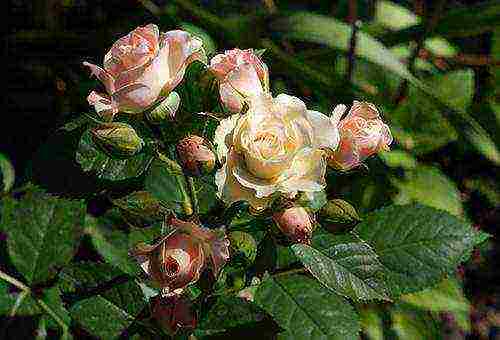
How curb roses reproduce
Miniature beauties reproduce in 3 ways:
- cuttings;
- dividing the bush (seedlings);
- seeds.
Propagation by cuttings
It is considered the easiest way. From May to July, semi-lignified shoots can be cut, divided into parts so that 2-3 buds remain on each of them. All the leaves on them are shortened by half.
Each shoot is planted only after 3-4 hours of keeping them in a root-forming solution. The distance between them when planting is 30-35 cm. Then each shoot is watered abundantly and covered with a container (glass jar, large plastic bottle). They stay in such a "greenhouse" for about a month and a half. All this time it is necessary to water them regularly. Once the shoots have developed roots, they can be dug up and transplanted to a new location in the garden.
Propagation by seedlings
This method is applicable in the fall or spring before bud break. It is very easy to divide an adult bush. It is dug up and neatly cut into pieces. The main thing to consider is that each part must have a shoot and roots. Then all the shoots obtained by dividing are planted in the garden.
Seed propagation
Florists very rarely resort to the propagation of a border rose by seeds, since this is a long and troublesome process.
All harvested (purchased) seeds are germinated at a temperature of +20 ° C for 2 weeks before planting. They can be sown in a container with fertile light soil in late autumn. The seeds are planted 0.5 cm deep. Throughout the winter, it is important to maintain a temperature for them from +3 to +5 ° C. In late spring or early summer, the seeds will begin to sprout.
When buying seeds, the main thing is not to make mistakes. You need to pay attention to the following factors.
- Shelf life. Expired seeds may not fully germinate or not germinate at all.
- The color of the purchased variety. The selected miniature roses should be combined with plants already growing in the garden, match them in color.
- Longitude of flowering. It is different for all varieties: some have early, others late flowering. It will be nice if the selected variety of roses complements the overall flowering of the plants.
- Planting requirements and care. To get active growth and flowering, you need to know the basic rules for growing the purchased variety.
- Landing time. This is also important, since many species are grown indoors for some time before being planted outdoors.
Advice
It is necessary to buy seeds only in a specialized store or point of sale, so that it does not turn out that rose hips will grow instead of roses.
No need to regret the time spent growing a rose in the garden. Miniature plants, in response to the care and maintenance of them, will delight everyone with their long and lush flowering.
Roses ... It is impossible to convey in words the smell and impression of these plants. And how delightfully they act on the beautiful half of our humanity, isn't it? And therefore more and more people are now trying to plant this amazing flower at home.
Roses first appeared in Europe. They were planted as ordinary plants, with only one type of variety.Now roses are abundant, in several varieties, of various colors and sizes. These flowers smell great and look good just as well. Now they can be grown both on the street and at home, only your desire to decorate the area is important.
Curb roses are most often used to decorate garden areas. Such exquisite, bright and compact flowers are perfectly combined with various garden plants.
Do you have border roses? How do they look?
A distinctive feature of these roses is abundant flowering, unusual shape and fluffy petals. During the season, they bloom again, take root well under different conditions, are not afraid of frost and belong to unpretentious flowers. These flowers are used to decorate city parks, and now they are in great demand for planting in private garden plots. The curb rose is highly regarded by landscape designers for its originality and decorative effect. Such roses are planted in March. All border roses are small in stature, and they are also shrubs that are very easy to care for. These flowers do not require complex technologies for planting and further growth.
Rose petals have a double base, as well as small fluffy bushes that bear fruit over time. You can see 3-4 flowering changes per year.
They can be planted in flower beds, lawns or gardens. There are many different varieties of border roses. Here, as they say, for your taste and color.
A curb rose can also look great in your home on a windowsill, which is well lit and has no draft. This is a wonderful gift for ladies.
If you decide to plant roses at home, then you will not need to insulate them. It is enough just to water and spray the plant from a spray bottle on time.
The curb rose is propagated by both seeds and cuttings. If you are an experienced gardener, then you can work hard with the seeds, and if you are a beginner, it is better to buy a cutting and plant.
Curb rose: reproduction and care
For breeding, it is very important to choose a flower bed that is well lit by sunlight. The curb rose loves sunbathing all day long. Also, the saturation of the color of the flower depends on the sun. But with all this, the landing site must be protected from strong winds. It is worth saying that curb roses do not withstand dampness and may deteriorate when planted.
But if you have a poorly lit flower bed, and you really want to plant a border rose, then you will have to work on lighting the flower bed. There are many ways to do this now.
When planting, you must take into account the time of year. It is better to plant roses in early spring so that their root system develops well and gets stronger in the ground. If conditions permit, you can plant it in the fall, and in the spring you can transplant already gorgeous rose bushes.
Do not forget about the elementary loosening of the soil. The curb rose, like other plants, loves him very much.
After planting, it is advisable to organize greenhouse conditions for the rose in order to protect the rose from temporary frosts.
How to insulate a curb rose when planting?
Since the rose is a small plant, insulating it will not be as difficult. When planting for the first time, it is covered with a cut bottle or jar. If you have a greenhouse on the site, then plant a rose there so that it grows stronger and does not freeze.
Just don't forget about watering and caring for it. By the way, an excessive change in weather can affect the cutting for the worse.
Curb roses: care
Rose bushes should look neat and lush, for which it is necessary to prune the plant in time and remove old stems. In this case, after winter, you need to prune the tops of the plant for splendor and growth.
Many rose breeders believe that organic and mineral supplements are essential for flowers.With proper care, you will notice several flowering phases until the most resistant frost, so you need to fertilize several times a year.
Do not forget that any plants, including roses, can get sick or meet pests. And this is also a reason to rid the flowers of these unpleasant ailments by feeding. Also, the proximity to other plants will help to repel pests or diseases.
Time to feed
- The first feeding is carried out in the spring with fertilizer to strengthen and protect against frost.
- The second is two weeks after the first.
- The third is in mid-June.
- The fourth is in July.
- The fifth is in August.
- The sixth is in mid-September.
- At the end of September, we carry out liming.
All dressings are carried out in turn: first with organic, and then with mineral fertilizers. They can be either purchased or homemade, which everyone has become accustomed to using for a long time. They have long established themselves on the positive side. It is only important to correctly calculate the dose of feeding.
Preparing roses for winter
Now you need to insulate the roses. Preparation for winter begins with laying spruce branches between the leaves and warming with foil. In this state, roses remain until the beginning of warming, until about April. With the onset of heat, they are ventilated, and after the soil freezes, the film is removed and the spruce branches are removed.
You can also spud roses before wintering. And good, but moderate watering after wintering is required.
To-do list after winter
- Shelter cleaning.
- Pruning roses.
- Protection from pests by neighboring plants.
- Regular watering of roses.
- Fertilizing roses.
- Correct cuttings and propagation of roses.
- Proper care at all times.
- Monthly loosening of the soil.
Propagation by cuttings
Reproduction begins in May and continues through June. Roses form shoots with young buds, which must be cut in half to obtain 2-3 buds.
Before planting the cuttings, you need to soak the buds in root growth solutions. Now there are a lot of them on sale. You can also use folk methods. For example, use a weak manganese solution. To do this, prepare a solution, put the kidneys in a glass and observe. Roots will begin to grow in two days.
Then, border roses are planted in a hole, preferably fertilized with sand and humus, under a slight slope. The distance between the flowers should be at least 18–32 cm. When planting, the remaining leaves fall off over time, and new ones grow in their place.
If you come across a stalk with a bud, then you need to pinch it, since the bud will take all the strength from the bud and will not allow the root to grow.
Also, young bushes are watered and covered with a cut bottle to arrange greenhouse conditions.
Two months after planting, you can dig up a sprouted rose bush and plant it in a permanent place. In this case, you should actively water and spray the plant, which will improve the quality and habituation of the flower in the soil.
What to look for when buying seeds
- When buying seeds, the main thing is not to make a mistake. You need to look very closely at the expiration date. Buy seeds that are not expired because they may be empty.
- Pay attention to the color of the rose: whether it will suit your flower bed or alpine slide, what shade you combine with other plants, whether it will not look ugly against the background of other roses.
- It is worth carefully studying the longitude of flowering, because it is diverse on different varieties. You should also know early flowering or late.
- You should definitely study the planting and grooming requirements, as they may differ in some way. And this must be taken into account immediately so that later there will be no oversights.
- Buy seeds in specialized stores so that later it turns out that instead of beautiful, shaggy border roses, you got a rose hip. In them, such an oversight is not allowed.
- The planting time is also worth considering, as you may need a special growing area, light and humidity.
There are many factors to consider when planting. You need to germinate the seeds, plant them as seedlings in pots and then wait for the shoots to germinate, and then carry out the usual transplanting.
Roses border varieties are very diverse. Let's take a look at some of them.
Garnet bracelet
The variety got its name due to its bright red color, beautiful thick double petals, and also under the influence of the story of the writer Kuprin.
The flowering of this variety is continuous until autumn. The plant is of medium size, frost-resistant, well resistant to diseases, as it has immunity to them. Rose Garnet bracelet is not particularly demanding to care and tolerates long sunny weather well.
Sunset
The flowers are large enough, have a well-defined aroma. They are thick double, rich bright yellow, which will look great on your flower bed or balcony. The beautiful yellow color makes this variety stand out from all others.
The variety is well resistant to fungal diseases, but less resistant to blackleg. Sunset Rose blooms profusely until the most resistant frosts and does not require any special conditions for cultivation and maintenance.
Masquerade
The variety got its name from the color change. The second name of the rose is Chameleon.
The color changes depending on the season: from a bright yellow color, it goes to pale pink and at the end it acquires a dark crimson. The color of the leaves is dark green, fine structure. The flower blooms profusely and beautifully, has a fruity scent, is well resistant to diseases and pests, frost-resistant and resistant to rain. Rose Masquerade on any flower bed will look impressive even on its own.
But the variety has special care requirements. After flowering and drying of the buds, they must be cut off for further flowering. With proper care, the rose blooms continuously.
